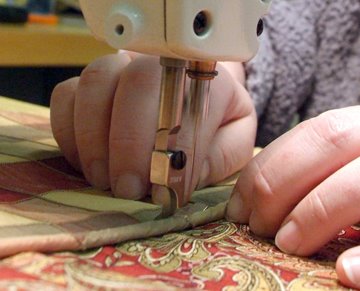 Source: Google Image Search
Source: Google Image SearchHelping out the environment is a new way people are helping out the world, one throw pillow at a time. Just as recycling our trash, and turning off the water and lights when not using them recycling materials can pay off in the long run; being kinder to our environment and prolonging the life or our planet! It may not be for everyone but it sure will feel good to help out our mother earth!
Many of our high end fabric makers, — Kravet, Robert Allen, Duralee and Schumacher – continue to expand on their eco-friendly offerings. At this time,
prices for eco friendly products continue to be higher than the other fabrics, however, as this market grows we can expect that in the future these prices will become more reasonable - providing the opportunity to reach out to an even wider market.
- The Kravet Green Collection is made of 100% recycled polyester.
- The recycled polyester is a unique blend of post-industrial and post-consumer fibers.
- The fabrics are woven and treated with no additional chemicals.
- During the finishing process, water based products and environmentally approved dyes are used.
- After years of enjoyable use, these fabrics are recyclable.
- Most polyester is manufactured using a catalyst called antimony trioxide, which is a possible human carcinogen. Eco Intelligent Polyester, however, is made from a fully optimized fiber using a new, environmentally safe catalyst.
- Designed with optimized dyestuffs and chemicals, which replace harmful chemicals and hazardous heavy metals.
- Designed to be safely recycled into new fabric at the end of its commercial life, with no hazardous by-products.
- Made with sustainable manufacturing processes, allowing limitless design and color.
- Eco Intelligent® Polyester is a synthetic textile designed for sustainability from start to finish.
The Robert Allen Group recognizes the importance of protecting the environment and providing sustainable products that range from waste reduction to energy efficiency.
The fabric that they designate as “eco-friendly” has met a criteria they've made based on strict environmental standards for fabric content, dye or pigment composition and also the finishing processes and treatments.
- At least fifty percent of the fibers in their eco-friendly fabrics are sustainable, organic and/or recycled.
- Sustainable fibers come from rapidly renewable resources with growth and harvest cycles of five years or less. Fibers that fall into this category include alpaca, bamboo, mohair, hemp, wool, and cork.
- Organic fibers are grown without the use of pesticides, fungicides, herbicides and chemical fertilizers. Fibers that fall into this category include organic cotton, organic hemp and organic linen.
- All of their organic fabrics are made from certified organic fibers.
- Recycled fibers come from post-consumer waste such as soda bottles.
- They also come from post-industrial waste: byproducts from the manufacturing process. Their post-industrial recycled fibers come from petroleum byproducts, recycled cotton, corn derivatives (PLA), recycled silk, and soybean husks.
COLOR:
- The eco-friendly fabrics may derive color from metal-free or reduced metal dyestuffs and pigments.
- If the fabrics contain dyes or pigments, they meet the metal content standards set by the Ecological and Toxicological Association of Dyes and Organic Pigments Manufacturers (ETAD).
- Their eco-friendly fabrics may be loom state, meaning that they come straight from the loom with no additional performance preparations.
- Eco-friendly fabrics with finishing treatments may include washing (with water alone or with a mild soap), aero-ing (tumbling), steaming and/or pressing with hot rollers.
- It is their preference not to use a stain repellent or a water repellent except in cases where they are a practical necessity and in these cases, they will offer the most environmentally-friendly option available
- Backings applied for Contract applications are polyester and in combination with a 100% recycled polyester fabric, the end product is completely recyclable.
For more "going green" ideas try these sites: Inhabitat and Treehugger or GreenDesignGirl
Visit Storibook Designs on Twitter or Facebook for more of our posts!











































































